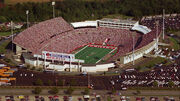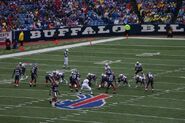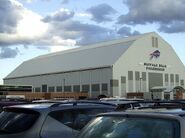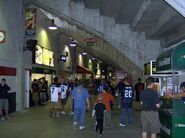
| Former names | Rich Stadium (1973–1998) |
|---|---|
| Location | 1 Bills Drive Orchard Park, NY 14127 |
| Coordinates | 42°46′25″N 78°47′13″W / 42.77361°N 78.78694°WCoordinates: 42°46′25″N 78°47′13″W / 42.77361°N 78.78694°W |
| Owner | Erie County, New York |
| Operator | Erie County, New York |
| Capacity | 80,020 (original) 73,079[1] (current) |
| Surface | AstroTurf 1973 to 2002 AstroPlay 2003 to 2010 A-Turf Titan 2011 to future |
| Construction | |
| Broke ground | April 4, 1972 |
| Opened | August 17, 1973 |
| Construction cost | $22 million USD ($109 million in 2024 dollars[2]) |
| Architect | HNTB |
| Tenants | |
| Buffalo Bills (NFL) (1973–present) | |
Ralph Wilson Stadium (originally Rich Stadium) is a football stadium, located in the town of Orchard Park, a suburb of Buffalo, New York. It is the home for the Buffalo Bills, of the NFL. The stadium is named after Pro Football Hall of Famer and current Bills owner Ralph Wilson.
History[]
What is now known as Ralph Wilson Stadium, also known as "The Ralph", is located in Buffalo, New York. While suitable for American Football League play, Buffalo War Memorial Stadium was both in disrepair and deemed undersized for a National Football League team, with a capacity of under 47,000 (league mandates instituted after the merger dictated a minimum of 50,000 seats).
The stadium opened in 1973. The construction of the stadium and its location were the source of years of litigation, which ended with a financial settlement for a developer who had planned to erect an all-weather stadium in Lancaster, New York. However, plans changed because it was not wanted to be close to Lancaster High School.[3] The stadium ended up being built by a man named Frank Schoenle, and his construction company. In 1972, Rich Products signed a 25-year, $1.5 million deal, by which the venue would be called "Rich Stadium"; this is one of the earliest examples of the sale of naming rights in North American sports. (The name was somewhat of a compromise, after Bills owner and founder Ralph Wilson rejected the name Rich wanted to use, "Coffee Rich Park.")[4] After the original deal expired in 1998, the stadium was renamed in honor of Wilson, after Rich balked at paying a greatly increased rights fee, which would have brought the price up to par with other NFL stadiums.
The first playoff game at the stadium was a 17–10 Bills victory over the Houston Oilers on January 1, 1989. The Bills won every ensuing playoff game at the stadium until they were defeated by the Jacksonville Jaguars on December 28, 1996.
Seating capacity[]
- 80,020 (1972-1983)[5]
- 80,290 (1984-1994)[6]
- 80,024 (1995-1998)[7]
- 75,339 (1999-2000)[8]
- 73,967 (2001-2007)[9]
- 73,079 (2008-present)[10]
Other sporting events[]
On January 1, 2008, the Buffalo Sabres hosted the Pittsburgh Penguins in the 2008 NHL Winter Classic.[11] The Penguins won 2–1 in a shootout, but, despite the loss, over 71,000 fans showed up making it the best attended NHL Winter Classic to date.
The stadium annually hosts the region's Section VI high school football playoffs.
The opening ceremony of the 1993 Summer Universiade was held at the stadium.[12]
Concerts[]
Occasional concerts that had high demand were prominently held at the stadium during the 1970's through 2001. This including The Grateful Dead, as documented on their Truckin' Up to Buffalo CD/DVD on July 4, 1989. The Who played the stadium on the their 1982 "Farewell" Tour and 1989 Tour. The last concert at the stadium in 2001 was an 'N Sync concert with Dream as a supporting act. The Rolling Stones played the stadium in 1981.
Metallica and Guns N' Roses brought their co-headlined Guns N' Roses/Metallica Stadium Tour to the stadium on July 25, 1992, with Faith No More as their opening act.
The stadium also held The Monsters of Rock Festival, featuring Van Halen, Scorpions, Dokken, Metallica & Kingdom Come, on June 19, 1988.
There were notable large concerts that were scheduled to take place at the stadium but was later canceled. Led Zeppelin was set to perform at the stadium on their 1977 North American Tour. The concert was canceled due to the death of lead singer Robert Plant's son. The last concert that would have played at the stadium was a Bruce Springsteen concert in 2003. That concert was canceled due to low ticket sales and moved to the smaller Darien Lake Performing Arts Center instead.
Concert appearances began to wane in the 1990's at the stadium. No concerts have been held at the stadium since 2001. This was due to the availability of other venues in Western New York such as Art Park in Lewiston, New York, Darien Lake Performing Arts Center in Corfu, New York and First Niagara Center, which opened in 1996, replacing Buffalo Memorial Auditorium in downtown Buffalo.
Non-sporting or music events[]
The stadium has also hosted the Drum Corps International championships three times.
Design[]
The stadium is open-air, with a capacity of 73,079.[13] The stadium has never had a natural grass surface; AstroTurf was installed in the stadium upon its opening in 1973. In the 2003 offseason the original turf was replaced with a newer AstroTurf product, AstroTurf GameDay Grass (also known as AstroPlay). In 2011, the Bills announced they would be changing their turf to a new product, A-Turf Titan, produced by a Western New York company, beginning in the 2011 season. Buffalo will be the only NFL stadium using the A-Turf Titan product.[14]
The stadium originally had a capacity of 80,020, however the capacity was reduced in 1998 as a part of the Bills lease renewal with Erie County, New York. The stadium at that time was refitted with larger seats and more luxury and club seating. The lease agreement also stipulated that Erie County would continue to upgrade the stadium; in summer 2007 a new High Definition Mitsubishi LED board measuring 88.8' by 32.5' and ribbon boards were installed. Total cost for the project was $5.2 million. The new scoreboard replaced the old 41.5' by 31.5' Sony JumboTron installed 13 years earlier for $8 million (inflation adjusted).
Buffalo, by virtue of its position downwind of Lake Erie, is one of the nation's windiest cities, and as a result, Ralph Wilson Stadium often is a difficult stadium for kickers, with swirling winds that change direction rapidly. This is exacerbated by the design of the stadium. The field is 50 feet below ground level, while the top of the upper deck stands only sixty feet above ground. The open end lies parallel to the direction of the prevailing winds, so that when the winds come in, they immediately drop down into the bowl, causing the stadium's signature wind patterns. Taking advantage of the stadium's windy conditions, micro-wind turbines, under the brand name TurboMill®, were installed by a company named WindStream Technologies allowing Ralph Wilson Stadium to leverage the wind gusts to create electricity for the stadium. [15]
Photo gallery[]
Notes[]
- ↑ Ralph Wilson Stadium Facts and Figures
- ↑ Consumer Price Index (estimate) 1800–2008. Federal Reserve Bank of Minneapolis. Retrieved December 7, 2010.
- ↑ http://www.history.buffalobills.com/Stadium+History
- ↑ http://www.buffalonews.com/life/article470666.ece
- ↑ "Leypoldt Boosts Bills to Victory". The Victoria Advocate. October 1, 1973. http://news.google.com/newspapers?id=1QRIAAAAIBAJ&sjid=y4AMAAAAIBAJ&pg=5748,74999&dq=en.
- ↑ Powers, John (December 16, 1984). "Ease on Down the Road: NFL Clubs Are Packing It In for New Cities and Sweetheart Deals". Boston Globe. http://pqasb.pqarchiver.com/boston/access/663123471.html?FMT=ABS&FMTS=ABS:FT&type=current&date=Dec+16%2C+1984&author=John+Powers%2C+Globe+Staff&pub=Boston+Globe+(pre-1997+Fulltext)&desc=EASE+ON+DOWN+THE+ROAD%3B+NFL+CLUBS+ARE+PACKING+IT+IN+FOR+NEW+CITIES+AND+SWEETHEART+DEALS&pqatl=google.
- ↑ "League Extends TV Blackout Deadline for Bills Game". The Buffalo News. December 25, 1995. http://nl.newsbank.com/nl-search/we/Archives?p_product=BN&p_theme=bn&p_action=search&p_maxdocs=200&p_topdoc=1&p_text_direct-0=0EAF98FDDE8BF7CA&p_field_direct-0=document_id&p_perpage=10&p_sort=YMD_date:D&s_trackval=GooglePM.
- ↑ Bouchette, Ed (September 1, 1999). "Bettis Practices Despite Swelling". Pittsburgh Post-Gazette. http://news.google.com/newspapers?id=AIsNAAAAIBAJ&sjid=GXADAAAAIBAJ&pg=3386,160549&dq=en.
- ↑ "Rain Chases Saints Indoors in Final Heavy Practice for Bills". The Baton Rouge Advocate. September 7, 2001. http://nl.newsbank.com/nl-search/we/Archives?p_product=AD&p_theme=ad&p_action=search&p_maxdocs=200&p_topdoc=1&p_text_direct-0=0EE6497D1899089A&p_field_direct-0=document_id&p_perpage=10&p_sort=YMD_date:D&s_trackval=GooglePM.
- ↑ Gaughan, Mark (September 26, 2008). "Deferring on Opening Kick Is a Growing Trend". The Buffalo News. http://nl.newsbank.com/nl-search/we/Archives?p_product=BN&p_theme=bn&p_action=search&p_maxdocs=200&p_topdoc=1&p_text_direct-0=12375F855613B008&p_field_direct-0=document_id&p_perpage=10&p_sort=YMD_date:D&s_trackval=GooglePM.
- ↑ 2008 Winter Classic
- ↑ http://www.nytimes.com/1993/07/08/sports/world-university-games-a-bit-of-athletic-history-is-made-in-buffalo.html
- ↑ [1]
- ↑ Glynn, Matt (2011-05-08). Local firm hopes to score points with Bills' new field. The Buffalo News. Retrieved 2011-05-09.
- ↑ NeoTech - Industry Innovation (2011-11-12). [2]. Retrieved 2011-11-16.
External links[]
| Events and tenants | ||
|---|---|---|
| Preceded by War Memorial Stadium |
Home of the Buffalo Bills 1973 – Present |
Succeeded by Current stadium |
| Preceded by Arrowhead Stadium Foxboro Stadium Byrd Stadium |
Host of the Drum Corps International World Championship 1990 1995 2001 |
Succeeded by Cotton Bowl Citrus Bowl Camp Randall Stadium |
| Preceded by First game |
Host of the NHL Winter Classic 2008 |
Succeeded by Wrigley Field |
| Preceded by Mile High Stadium Joe Robbie Stadium |
Host of AFC Championship Game 1991 – 1992 1994 |
Succeeded by Joe Robbie Stadium Three Rivers Stadium |
| |||||||||||||||||||||||||||||||||
| ||||||||||||||||||||||||||||||||||||||||||||||||||||||||||||||||







